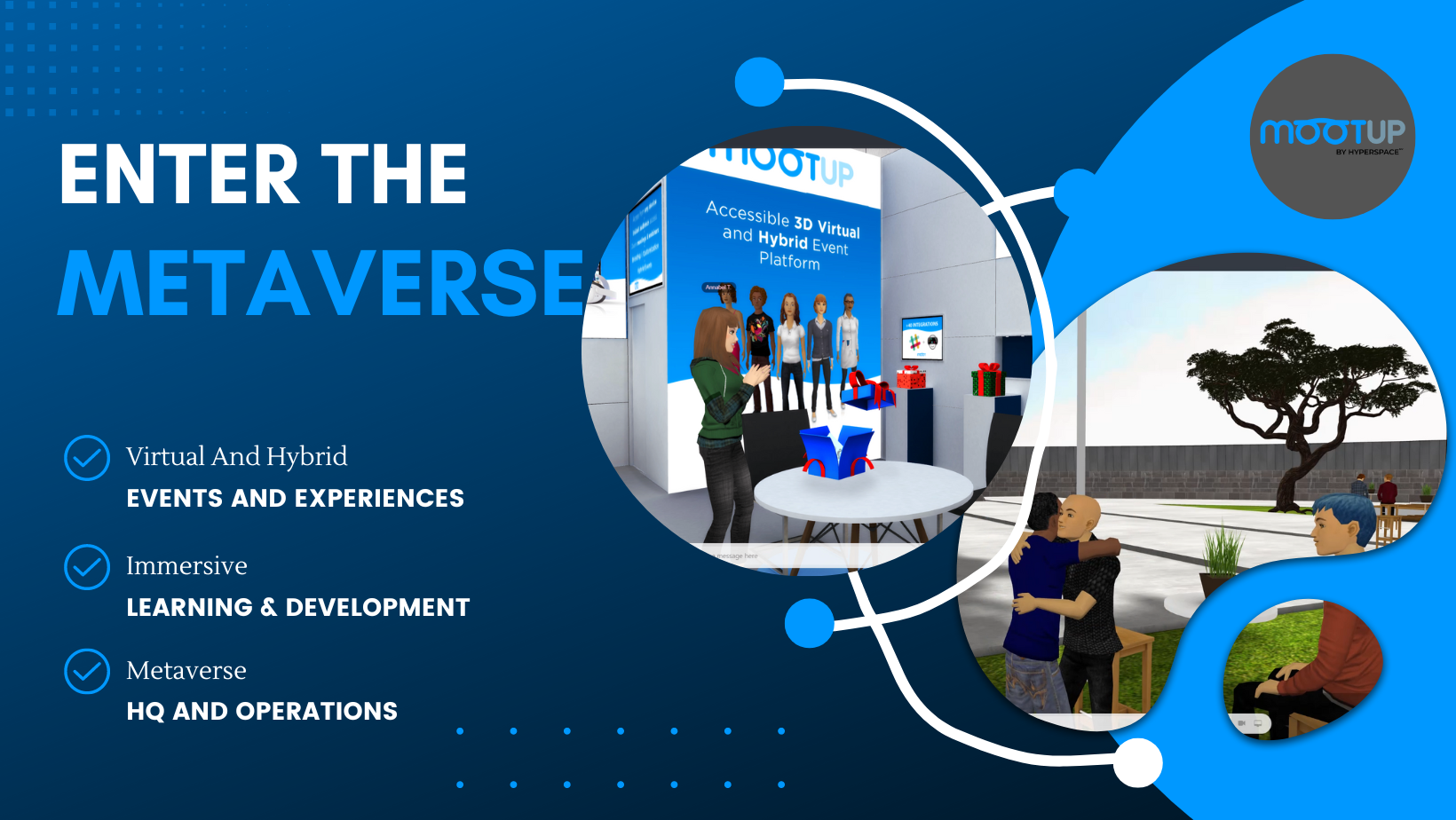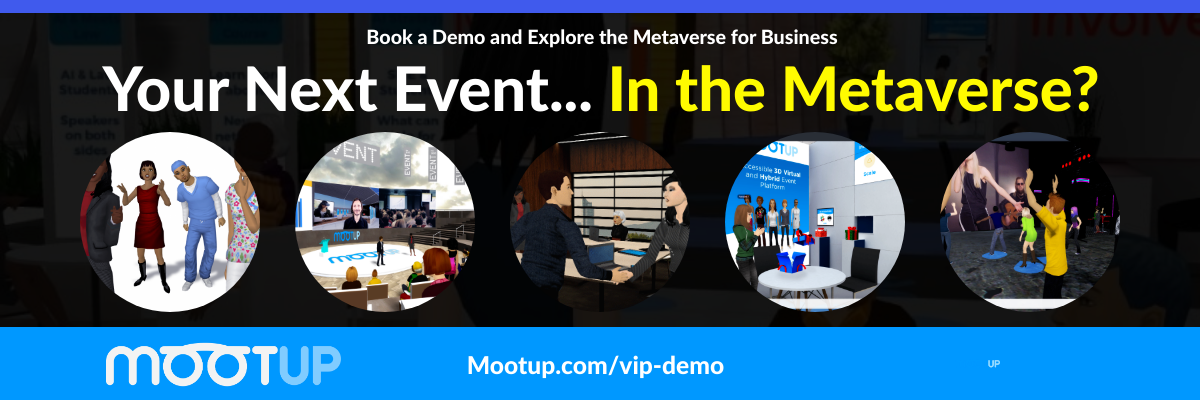In recent years, the event industry has significantly shifted towards incorporating a virtual event into its repertoire. As technology advances and global circumstances evolve, the demand for successful virtual event strategies grows. This blog post will explore various aspects of this emerging trend of adding a virtual event and provide valuable insights for event professionals seeking to adapt.
We will explore how virtual events offer increased ROI through reduced expenses and geographical accessibility for attendees. Furthermore, we’ll discuss hybrid event strategies combining in-person gatherings, virtual event platforms, and online components to maximize reach while utilizing cutting-edge AR technology for immersive experiences.
Lastly, we will cover essential tips for planning successful virtual events by focusing on content delivery methods, presenter environment integration, and audience participation features like live chats or Q&A sessions. By understanding these key elements of a virtual event strategy, you can stay ahead in the ever-evolving world of live events.
Table of Contents:
- The Rise of Virtual Events
- Increased ROI through Reduced Expenses
- Geographical Accessibility for Attendees
- Hybrid Event Strategies
- Planning Successful Virtual Events
- The Future of Virtual Events
- Frequently Asked Questions A Virtual Event
- Conclusion
The Rise of Virtual Events
With the pandemic, virtual events have become the norm for many industries. They offer improved ROI and minimal costs compared to in-person gatherings while providing attendees efficient content engagement without geographical limitations. This shift has led non-IT companies to adopt virtual solutions that often outperform their physical counterparts.
Increased ROI through Reduced Expenses
A major advantage of hosting a virtual event is its cost-effectiveness compared to traditional in-person events. Organizers can save on expenses such as venue rental, catering, travel accommodations, and other logistical costs associated with physical gatherings. As a result, businesses can allocate more resources toward virtual event platforms creating engaging content and marketing efforts that drive higher attendance rates.
Geographical Accessibility for Attendees
Participants worldwide can join virtual events without geographical or temporal limitations, giving organizers a global reach to access diverse markets and audiences. Organizers can now access different markets and groups of people who may not have been able to participate in an on-site event due to geographical or monetary issues. Moreover, this accessibility increases networking opportunities among professionals within various industries seeking new connections or partnerships during these online engagements.
- No need for expensive venues: Venue rentals are no longer necessary when organizing a virtual event since everything occurs online.
- Savings on travel expenses: Gone are days when attendees had to book flights and hotels to participate in industry conferences; now, they can log onto their computers at home.
- Easier access across different time zones: This feature ensures everyone interested gets an equal opportunity to participate regardless of geographical location.
In summary, the rise of virtual events has provided businesses with a cost-effective and accessible solution for hosting professional gatherings. By leveraging these benefits, companies can maximize their ROI while expanding their reach to new audiences across the globe.
Virtual events have revolutionized the event industry by providing increased ROI and greater geographical accessibility. Hybrid events are becoming more popular as they combine in-person and virtual components for maximum reach, utilizing AR technology to create immersive experiences.
Key Takeaway:
A no-code platform is being developed to create and host virtual and hybrid events in the Metaverse. For example, a virtual event can be easily organized using this platform.
Hybrid Event Strategies
In the rapidly evolving event industry, organizers must develop a hybrid strategy combining in-person and virtual elements. This approach allows businesses to transition traditional gatherings into dual models capable of reaching wider audiences while maintaining engagement levels. Moreover, incorporating augmented reality (AR) technology can significantly enhance the immersive experiences within these platforms.
Combining In-Person and Virtual Components for Maximum Reach
Organisations must balance physical attendance and remote participation to create an effective hybrid event. By offering multiple ways to attend virtual events, such as live streaming sessions or on-demand content access, you can cater to diverse interests and preferences among your target audience. Additionally, providing networking opportunities through virtual event chat features can foster meaningful connections among attendees regardless of their location.
- Create engaging content accessible both online and offline.
- Leverage live streaming technologies for real-time interaction with remote participants.
- Promote networking opportunities via dedicated chat rooms or forums during the virtual event life cycle.
Utilizing AR Technology for Immersive Experiences
AR technology has become increasingly popular in creating captivating environments at hybrid events. With its ability to overlay digital information onto physical spaces seamlessly, AR offers unique possibilities when designing interactive experiences tailored specifically towards each attendee’s needs – whether they are attending in person or remotely via a virtual platform like MootUp (mootup.com/what-is-virtual-event-management/). Some ways to incorporate AR technology into your hybrid event strategy include:
- Enhancing presentations with interactive, digital elements that in-person and remote attendees can access.
- Offering virtual tours of event spaces or product demonstrations for those unable to attend physically.
- Creating gamified experiences that encourage attendee engagement across all platforms.
A well-rounded hybrid event strategy is essential for maximizing reach and ensuring an engaging experience for all participants. By combining the best aspects of in-person gatherings with the convenience and accessibility of virtual events, organizers can create memorable experiences while expanding their audience base significantly. As you plan your next event, consider how these strategies could help elevate it to new heights.
Hybrid events are a great way to reach in-person and virtual audiences. However, careful planning is needed for successful outcomes. Producing engaging virtual events can be an exciting challenge with the right tools.
Key Takeaway:
A team is developing a no-code platform to create and host virtual and hybrid events in the Metaverse. The team is organizing a virtual affair to demonstrate the potential of their no-code platform for hosting and constructing hybrid events in the Metaverse.
Planning Successful Virtual Events
In the ever-evolving world of virtual events, planning and executing them effectively is crucial. Several factors contribute to a successful virtual event or online conference experience. This includes quality content delivery methods, seamless integration between presenters’ environments, engaging audience participation features such as live chats or Q&A sessions, and robust email marketing campaigns driving demand for registration slots.
Content Delivery Methods and Presenter Environment Integration
To make your virtual event stand out, provide top-notch material across various media, such as webinars, video presentations, podcasts and interactive seminars. Additionally, ensure seamless integration between the presenter’s environment (e.g., slides) and the hosting platform. Some popular platforms include Zoom, Microsoft Teams, and MootUp’s own no-code platform designed specifically for producing & hosting virtual events in the Metaverse.
Audience Participation Features Like Live Chats or Q&A Sessions
- Live Chats: Implementing a live chat feature allows attendees to interact with each other during presentations while also providing an opportunity for real-time feedback from speakers. This can create a more dynamic atmosphere within your virtual event.
- Q&A Sessions: Offering dedicated time slots for question-and-answer sessions enables participants to engage directly with presenters – fostering deeper connections between attendees and industry experts.
- Polls and Surveys: Collecting attendee feedback through polls and surveys can help you gauge the success of your virtual event, identify areas for improvement, and gather valuable insights to inform future events.
To ensure that remote attendees have a positive experience during your virtual event, encourage them to use headphones for optimal audio quality. Additionally, presenters should utilize plain backgrounds behind speakers and position cameras slightly above eye level to maintain a professional appearance throughout the presentation.

MootUp, a no-code platform designed specifically for producing & hosting virtual events in the Metaverse, offers online events features and more – making it an ideal choice for businesses looking to create engaging online experiences without breaking their budget.
Planning successful virtual events requires a thorough understanding of content delivery methods, presenter environment integration and audience participation features. With the emergence of the Metaverse as an event-hosting platform, it is clear that there are new opportunities for creating events online with engaging experiences in the future of virtual events.
Key Takeaway:
A no-code platform is being developed to create and host virtual and hybrid events in the Metaverse. As an example, a virtual event can be produced using this platform.
The Future of Virtual Events
As the industry continues evolving, experts agree that virtual events will remain relevant across various sectors and the virtual world – especially SaaS brands. Brands must invest time and resources into understanding how best to leverage these opportunities while identifying value propositions inherent within content delivery mechanisms employed during digital presentations. This ensures maximum ROI through high participation rates regardless of attendee engagement levels in trade shows.

Embracing New Technologies for Enhanced Experiences
Utilizing the latest advancements in AR, VR and AI technologies can greatly improve virtual events in the virtual world by providing immersive environments, facilitating real-time interactions between attendees and offering personalized experiences. These cutting-edge tools and on-demand content can help create immersive environments, facilitate real-time interactions between attendees, and provide personalized experiences based on individual preferences. For instance, AR technology can overlay digital information onto physical objects or spaces during a presentation, making it more engaging and interactive for remote participants.
Tailoring Content for Different Audiences
To maximize audience reach and engagement in future virtual events, organizers must focus on creating tailored content catering to different demographics and interests. This includes developing segmented marketing strategies targeting specific groups with customized messaging; offering multiple tracks or sessions catering to varying skill levels; incorporating diverse formats like webinars, workshops, and panel discussions – all aimed at providing an enriching experience for every participant.
- Segmented marketing: Targeting specific audiences with customized messages helps increase registration numbers by appealing directly to their needs.
- Multitrack sessions: Offering a variety of session types and topics allows attendees to choose the content that best suits their interests.
- Diverse formats: Incorporating different presentation styles keeps participants engaged throughout the event, preventing “virtual fatigue.”
Leveraging Data Analytics for Continuous Improvement
Data analytics is essential in optimizing virtual events by providing valuable insights into attendee behavior, preferences, and engagement levels. By analyzing this data, organizers can identify areas for improvement and make informed decisions about future event strategies. Some key metrics to track include registration numbers, attendance rates, session views or replays watched – all crucial overall success indicators.
To stay ahead in the ever-evolving landscape of virtual events, it is vital for brands to adapt their strategies based on emerging trends and technologies continuously. This includes embracing innovative tools like AR/VR/AI; tailoring content delivery methods according to audience preferences, leveraging data analytics for continuous improvement – ultimately ensuring maximum ROI achieved through high participation rates regardless of attendee engagement levels.
Key Takeaway:
A team is developing a no-code platform to create and host virtual and hybrid events in the Metaverse. As an example, they are planning a virtual event using this platform.
Frequently Asked Questions A Virtual Event
What is good about virtual events?
Virtual events offer numerous benefits, including reduced expenses, increased accessibility for attendees from different locations, flexibility in scheduling and content delivery, enhanced data collection capabilities, and the ability to reach a wider audience. They also provide opportunities for innovative engagement through interactive features like live chats or Q&A sessions.
What are examples of virtual events?
Examples of virtual events include webinars, online conferences or summits, product launches or demos, training workshops or courses, virtual trade shows, networking sessions and social gatherings. These can be hosted on various platforms such as Zoom Webinar ServicesZoom, Microsoft Teams Live EventsMicrosoft Teams, and Cisco Webex EventsCisco Webex.
What is the purpose of a virtual event?
The primary purpose of a virtual event is to engage an audience remotely by delivering valuable content and facilitating interaction between participants. Virtual events enable organizations to achieve their objectives – sharing knowledge or expertise with others; promoting products/services; building brand awareness; fostering community-building among members/participants; generating leads/sales prospects – without physical constraints.
How do you write a virtual event description?
To write an effective virtual event description, start by clearly stating its purpose/goals/objectives. Highlight key topics/presenters/experts, emphasize the benefits for attendees (learning opportunities, networking possibilities), and provide logistical details such as date/time/duration/platform. Use engaging language to create excitement around the event while maintaining a professional tone.
Conclusion
Virtual events have become increasingly popular for hosting conferences, workshops, and other gatherings. With the right organization and forethought a virtual event can be as effective – if not more so – than in-person ones. The trick is grasping what it takes to produce a wonderful event that guests will relish and recall for many years. By leveraging tools such as chat rooms, content streaming platforms, interactive presentations and engaging activities tailored specifically for a virtual audience – you’ll be able to create an unforgettable experience with your next virtual event.
Mootup‘s browser-based platform empowers you to “futureproof” your Metaverse, granting seamless access across smartphones, tablets, laptops, and VR/AR headsets without needing downloads or software installation, ensuring unparalleled convenience for all users.
Experience the future of events with MootUp, our no-code platform that allows you to create and host virtual and hybrid events in the Metaverse. Our solution will revolutionize how you plan your next event!

